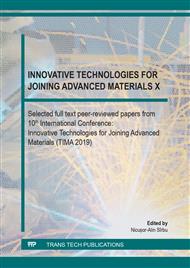[1]
Y. Kawamura, T. Shoji, Y. Ohno, Welding technologies of bulk metallic glasses, Journal of Non-Crystalline Solids, 2003,317, p.152–157.
DOI: 10.1016/s0022-3093(02)02005-7
Google Scholar
[2]
Klas Weman, Welding processes handbook – Second edition, Woodhead Publishing Limited, Stockholm, (2012).
Google Scholar
[3]
J.H. Kim, C. Lee, D. M. Lee, J.H. Sun, S.Y. Shin, J.C. Bae, Pulsed Nd:YAG laser welding of Cu54Ni6Zr22Ti18 bulk metallic glass, Materials Science and Engineering A, 2007, 449-451, p.872–875.
DOI: 10.1016/j.msea.2006.02.323
Google Scholar
[4]
L. Shao, A. Datye, J. Huang, J. Ketkaew, S. W. Sohn, S. Zhao, S. Wu, Y. Zhang, U. D. Schwarz, J. Schroers, Pulsed Laser Beam Welding of Pd43Cu27Ni10P20 Bulk Metallic Glass, Scientific Reports, 2017, 7, 7989.
DOI: 10.1038/s41598-017-08460-6
Google Scholar
[5]
J. Kim, Y. Kawamura, Electron beam welding of the dissimilar Zrbased bulk metallic glass and Ti metal, Scripta Materialia, 2007, 56, p.709–712.
DOI: 10.1016/j.scriptamat.2006.12.046
Google Scholar
[6]
Y. Kawamura, Y. Ohno, Spark welding of Zr55Al10Ni5Cu30 bulk metallic glasses, Scripta Materialia, 2001, 45, pp.127-132.
DOI: 10.1016/s1359-6462(01)01003-x
Google Scholar
[7]
C. H. Wong, C. H. Shek, Friction welding of Zr41Ti14Cu12.5Ni10Be22.5 bulk metallic glass, Scripta Materialia, 2003, 49, p.393–397.
DOI: 10.1016/s1359-6462(03)00306-3
Google Scholar
[8]
G. Wilde, Physical Metallurgy of Nanocrystalline Metals, Physical Metallurgy (Fifth Edition), 2014, pp.2707-2805.
DOI: 10.1016/b978-0-444-53770-6.00026-5
Google Scholar
[9]
C. Codrean, V. A. Serban., Metale amorfe si nanocristaline, Ed. Politehnica Timisoara, 2007, pp.9-114.
Google Scholar
[10]
J. A. Gallego-Juarez, K. F. Graff, Power Ultrasonics Applications of High-intensity Ultrasound, Woodhead Publishing, Cambridge, (2014).
Google Scholar
[11]
X. Song, Z. Zhu, Y.Chen, Ultrasonic Welding of Fe78Si9B13 Metallic Glass, Materials Science Forum, Vols 809-810, 2015, pp.348-353.
Google Scholar
[12]
J. Kim, Weldability of Cu54Zr22Ti18Ni6 bulk metallic glass by ultrasonic welding processing, Materials Letters, 2014, 130, p.160–163.
DOI: 10.1016/j.matlet.2014.05.056
Google Scholar
[13]
W. Wu, J. Jiang, G. Lia, J. Ying, H. Fuh, H. Jianga, P. Gou, L. Zhang, W. Liu, J. Zhao, Ultrasonic additive manufacturing of bulk Ni-based metallic glass, Journal of Non-Crystalline Solids, 2019, 506, p.1–5.
DOI: 10.1016/j.jnoncrysol.2018.12.008
Google Scholar
[14]
K. F. Graff, M. Short, M. Norfolk, Very high power ultrasonic additive manufacturing (VHP UAM) for advanced materials, in Solid freeform fabrication symposium,, Austin, Texas, (2010).
Google Scholar
[15]
V.K. Patel, S.D. Bhole, D.L. Chen, Ultrasonic spot welding of aluminum to high-strength low-alloy steel: microstructure, tensile and fatigue properties, Metall. Mater. Trans. A, 2013, 45, p.2055- (2066).
DOI: 10.1007/s11661-013-2123-y
Google Scholar
[16]
D. Ren, K. Zhao, M. Pan, Y. Chang, S. Gang, D. Zhao, Ultrasonic spot welding of magnesium alloy to titanium alloy, Scr. Mater. 2017, 126, pp.58-62.
DOI: 10.1016/j.scriptamat.2016.08.003
Google Scholar
[17]
M. Maeda, Y. Takahashi, M. Fukuhara, X. Wang, A. Inoue, Ultrasonic bonding of Zr55Cu30Ni5Al10 metallic glass, Mater. Sci. Eng., B, 2008, 148, pp.141-144.
DOI: 10.1016/j.mseb.2007.09.028
Google Scholar
[18]
A. A. Ward, M. R. French, D. N. Leonard, Z. C. Cordero, Grain growth during ultrasonic welding of nanocrystalline alloys, J. Mater. Process. Technol., 2018, 254, pp.373-382.
DOI: 10.1016/j.jmatprotec.2017.11.049
Google Scholar
[19]
A. A Ward, Y. Zhang, Z. C. Cordero, Junction growth in ultrasonic spot welding and ultrasonic additive manufacturing, Acta Materialia , (2018).
DOI: 10.1016/j.actamat.2018.07.058
Google Scholar
[20]
J.J. Byron, Vibratory welding process and apparatus, Sonobond Corp., (1962).
Google Scholar


